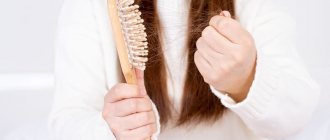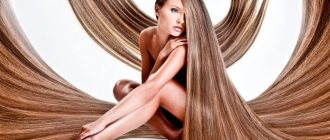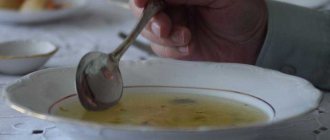According to statistics, every second woman has experienced intense hair loss in her life. And although a decrease in hair density cannot but upset you, you don’t need to immediately suspect that you have some kind of serious illness. Sometimes hair loss is just a temporary reaction of the body to stress, illness, medication, pregnancy and childbirth, or other unusual mental and physical conditions. There is no need to worry too much about this; hair growth will recover on its own without any additional products or procedures. However, if severe hair loss continues for several months and leads to a noticeable decrease in thickness, this is a reason to become concerned about the condition of the hair follicles and the entire body and take measures so as not to be left completely without hair.
Types of hair thinning in women
Androgenetic (androgenic) alopecia
Androgenetic alopecia (AGA) is the most common cause of hair loss in both men and women: it accounts for over 90% of all alopecia. Androgenetic alopecia does not impair a person’s physical health in any way. This is an exclusively cosmetic problem, but it significantly impairs the quality of life, causing psychological discomfort.
Androgenetic alopecia is found in people whose hair follicles are genetically sensitive to androgens (male hormones). In the presence of such sensitivity, dihydrotestosterone has a negative effect on the hair follicles, as a result of which they decrease in size, thin out and die over time.
Androgenetic alopecia changes the hair growth cycle. The active growth phase (anagen) is shortened, and the resting phase (telogen), when the hair does not grow, lengthens. The ratio of anagen to telogen periods becomes less than 8:1, with the norm being 12:1. With each cycle, the anagen phase becomes shorter and shorter, while the telogen phase remains the same. Changes in the hair growth cycle lead to shortening of the overall hair length. Over time, the size of hair follicles decreases. Normal, healthy, thick hair is replaced by thin (vellus) hair that appears unhealthy and sparse.
Female hair loss pattern
With androgenetic alopecia in women (female pattern of hair loss), the volume of hair in the frontoparietal zone decreases. Thinning on the crown is rare.
There are three stages of hair loss in women (according to the Ludwig scale): Stage 1 is characterized by noticeable thinning of hair in the frontoparietal zone and widening of the parting, while the marginal hairline remains unchanged. Stage 2 is diagnosed when there is severe hair thinning in the frontoparietal area. Stage 3 , in which hair in the frontoparietal zone is completely lost, is extremely rare.
Ludwig scale
Thinning in the central parting area
Thinning in the side parting area
Unlike men with androgenetic alopecia, women with the same diagnosis do not lose hair as intensely and abundantly, so there are practically no completely bald women. In addition, androgenetic alopecia begins to appear in women at a later age than in men and is more treatable.
The influence of hormones (androgens) on hair growth and loss
The effect of androgens on hair loss in men has been thoroughly studied and fully proven. As for women, in some cases there is indeed a relationship between hair loss and increased levels of male hormones in women (hyperandrogenism). In addition to hair loss, hyperandrogenism can also manifest itself with symptoms such as acne, hirsutism (increased facial and body hair), and menstrual irregularities. However, all these manifestations can occur even with normal levels of male hormones. Thus, hair loss that follows a female pattern is not always a consequence of hyperandrogenism. Genetic factors play a leading role in hair thinning in both women and men.
Treatment
Therapy with external and internal means
The most effective treatment for stopping hair loss and restoring hair growth is the following regimen: - Androgen receptor antagonists - cyproterone acetate (used in Europe and Canada) and spironolactone (used in the USA). These substances work to stop hair loss. — Hair growth stimulants – minoxidil, nitrolipins (Regeus).
Preparations containing these substances are applied externally directly to the areas of hair thinning and/or taken orally. The regimen and duration of treatment are determined individually. The earlier therapy is started, the higher its effectiveness. In later stages, when conservative treatment does not help, hair transplantation or the use of concealers is recommended.
Injections
The treatment method for androgenetic alopecia is based on the natural activation of regenerative processes. The essence of the method is to use your own cells, namely platelet-rich plasma. The drug is administered intradermally or subcutaneously, the course lasts at least 3 months. The treatment regimen is selected individually. Injection of platelet-rich plasma leads to the activation of key growth factors such as platelet-derived growth factor (PDGF), transforming growth factor (TGF), vascular endothelial growth factor (VEGF) and epidermal growth factor (EGF). This cascade of reactions leads to regeneration and repair and ultimately to the restoration of the physiological cycle of hair follicles.
Traditional methods of treating alopecia
There are many folk recipes for increasing hair thickness. The most popular of them are scalding masks based on pepper. In the scientific and medical community, this method of treating alopecia is treated with skepticism and humor. Pepper, although it increases blood flow while applying the mask, cannot thus restore the normal functioning of the hair follicles. Using traditional recipes is not only useless, but can also be dangerous for the skin. However, some people are confident in the effectiveness of such remedies. Here you can read where these beliefs come from: https://regeus.ru/blog/it-will-help-a-folk-remedy-to-stop-hair-loss-and-regain-hair-density
Hair loss due to menopause
A separate and fairly common type of alopecia in women is hair loss due to menopause. At the same time, the level of androgens (male hormones) in women can be either elevated or within normal limits. The classic treatment for alopecia caused by menopause is oral finasteride or dutasteride (prohibited for use in women in the Russian Federation). The dose and regimen are selected individually.
Diffuse alopecia
Other names: telogen effluvium, symptomatic alopecia, telogen effluvium hair loss. Telogen effluvium hair loss is characterized by the loss of more than 100 hairs per day, with hair falling out evenly over the entire surface of the scalp. Of the hair shed, most of it is in telogen rather than anagen.
Causes
Acute telogen effluvium occurs in childhood after infections, as well as in women from 30 to 50 years old and can last 3-6 months. In women of any age (including the elderly), acute telogen effluvium can occur against the background of androgenetic alopecia and aggravate its course. In such cases, the patient is given two diagnoses at once: androgenetic alopecia and diffuse alopecia, although this is quite rare.
“In my practice, there was such a case, and the patient was convinced that the doctors simply could not understand what was wrong with her, that the diagnoses differed and this aggravated her psychological state (and this could aggravate hair loss). Please trust your doctors, ask questions, study scientific articles if you don't believe anyone. The effectiveness of treatment depends on this. Fortunately, such types of diagnostics as trichoscopy and trichogram help in making both diagnoses.”
Elizaveta Dubinskaya Dermatologist, trichologist
Provoking factors for diffuse hair loss: surgical interventions, hospitalization, taking certain medications (neuroleptics, anticoagulants, interferons). If diffuse hair loss continues for more than 6 months with exacerbations, then a diagnosis of chronic telogen effluvium is made. There are two forms of such alopecia: - primary idiopathic, predominant in women before menopause; - secondary, occurring against the background of systemic chronic diseases (especially against the background of hypothyroidism), as well as against the background of conditions such as nutritional deficiency, stress, depression, malignant neoplasms. Young patients with seborrheic dermatitis also experience increased hair loss in the telogen phase, but this issue still requires clarification of the cause-and-effect relationship.
Diagnosis and treatment
The differences between diffuse and androgenetic alopecia are not always obvious; moreover, cases of transition from diffuse to androgenetic alopecia have been recorded (Sinclair et al., 2004). Non-invasive diagnostic methods: hair traction test, hair washing test, dermatoscopy and trichogram are sufficient to establish most diagnoses. Histological examination may help but is rarely required. To treat telogen effluvium, it is important to quickly identify and, if possible, eliminate the triggering factors. No special acute treatment is required, and most patients recover spontaneously within six months. The prognosis for chronic telogen effluvium is uncertain; spontaneous improvement may occur after several years.
Alopecia areata
Alopecia areata is a chronic disease of the hair follicles, manifesting itself in the form of round, non-scarring foci of hair loss on the head, and less often on the body.
Causes
Many authors consider the autoimmune nature of the disease, when cells of the immune system attack hair in the growth phase. The interaction of aggressive lymphocytes with hair follicle cells, abnormal expression of certain tissue antigens, and the initiation of apoptosis (programmed cell self-destruction) contribute to the development of autoimmune inflammation.
Among the factors contributing to the development of the disease: genetic predisposition, microcirculatory and immune disorders, endocrine and metabolic disorders, adverse environmental influences. In addition, nervous system disorders at various levels play an important role. The literature has now accumulated a lot of data indicating various emotional disorders, the presence of hypothalamic pathology and autonomic disorders in patients with alopecia areata.
How does alopecia areata manifest?
Clinical picture: - presence of alopecia foci on the skin with clear boundaries; - the presence of stumps of hair in the lesion in the form of an exclamation mark and a “loose hair zone” at the border of the lesion (active stage); - detection during microscopic examination of hair epilated from the lesion of dystrophic proximal ends in the form of a “broken rope”; - the presence of light vellus hair in the growth area (in the regression stage); - sometimes along one edge of the lesion there are fragments of hair in the form of an exclamation mark, and on the opposite - the growth of thin hair; - detection during examination of nails of signs of onychodystrophy: thimble-shaped indentations, longitudinal striations, changes in the free edge in the form of wavy patterns.
If the disease is less than 1 month old, the following subjective symptoms may occur: hyperemia, burning, itching in the area of hair loss.
Treatment
Considering the autoimmune mechanism for the development of baldness, the main therapeutic direction is immunosuppression.
In very severe forms, drugs from the group of glucocorticosteroids are prescribed orally. For milder forms, external treatment with drugs of the same group is used. Intradermal injections of diprospan are used simultaneously with the main line of therapy.
The course of the disease is often unpredictable; pathogenetic therapy does not always promote hair restoration and does not guarantee that there will be no relapses. To maintain hair growth, treatment must be continued until complete remission occurs.
Separately, it is worth mentioning the effectiveness of cryotherapy for the treatment of alopecia areata.
The effectiveness of cryotherapy for alopecia areata
Cryotherapy, a treatment with liquid nitrogen for the treatment of alopecia areata, is not widely used, although cryotherapy machines are available in dermatology offices.
The possibility of using cryotherapy in the treatment of alopecia areata was described back in 1986. The therapeutic effectiveness of surface cryotherapy has been proven in various studies. For example, studies have been conducted to evaluate the effectiveness of treatment of alopecia areata with cryotherapy (1 treatment every 2 weeks for 12 weeks) and 0.05% clobetasol propionate lotion. It was shown that despite the lack of complete hair restoration (>95%), the response to treatment was 80% and 91.5%, respectively. This indicator is considered very worthy, taking into account the almost complete absence of side effects with cryotherapy, in contrast to clobetasol propionate. In a large study conducted on more than 350 patients, it was shown that 61% of respondents experienced restoration of normal guard hair growth, and at the initial stage of the disease and short intervals between procedures (no more than 2 weeks), the proportion of positive results was higher.
A large retrospective study published in 2006 found that 68.6% of 153 patients with alopecia areata achieved significant hair improvement, including terminal hair growth within 12 weeks of treatment. In 2021, a prospective study was conducted to compare the effectiveness of superficial cryotherapy and topical steroids as a therapeutic option. It was shown that 73% of patients experienced hair growth after cryotherapy (including 13% who experienced complete restoration of the lesion). Along with the general clinical improvement, the number of terminal (guard) hairs on the treated part of the head significantly increased by 1.6 times, in contrast to the control part, on which no significant changes were observed. Of course, one should remember the possibility of spontaneous remission, which occurs in 34% ~ 50% of patients during the first year of the disease. However, it cannot be ignored that the positive treatment results obtained in the various studies described can be interpreted as a significant therapeutic effectiveness of cryotherapy in the treatment of alopecia areata.
Thus, due to the minimally painful nature of the damage during the procedure and minimally invasive effects, superficial cryotherapy has been found safe and effective in the treatment of alopecia areata.
Traction alopecia
Traction alopecia is hair loss due to external traumatic action on the hair follicle. The main reasons for the development of the disease: frequent tugging, improper combing and addiction to tight hairstyles, including tight ponytails, frequent twisting of hair into buns, tight curlers, backcombing, dreadlocks. As a rule, the most affected hair is along the forehead, on the back of the head and temples, in the parting area, between the braids.
At the initial stage, traction alopecia may manifest itself as soreness of the scalp. At this stage, the disease is easily treatable: it is enough to eliminate the traumatic factor, change the hairstyle, and hair growth is restored on its own. However, if the problem is neglected, irreversible processes may begin; the disease will progress to the stage of cicatricial alopecia, when the hair follicles cease to exist. Unfortunately, with cicatricial alopecia, no remedies will help restore hair growth.
What hairstyles are most likely to cause traction alopecia?
Dreadlocks
Once you have dreadlocks, a person can wear them for several years. To achieve this hairstyle, hair - natural and synthetic - is twisted together to lengthen and add volume. Because of this, the weight of the hair and the load on the hair follicle increases. In addition, the hair is constantly tense: stretched and fixed in one direction - this leads to its excessive fragility and breakage. If you decide to get dreadlocks, there is a risk that you will remove them along with all your hair. This is perhaps the most dangerous hairstyle.
Braids
Tight weaving of hair, joining in different directions, fixing in rows and lines when creating complex patterns severely injures the hair and provokes hair loss. Beautiful, complex weaves can be done sometimes, but for a daily hairstyle it is better to choose something else.
Bouffant
Backcombing also injures and damages strands, overloads the roots and can lead to hair loss. Hairstyles that require backcombing are also best done on special occasions and not overused. Otherwise, in an effort to have a voluminous hairstyle, you can lose this volume irrevocably.
Postpartum hair loss
Hair loss in women due to pregnancy, childbirth, and lactation is a normal physiological process caused by hormonal changes in the body. Treatment during this period is ineffective. Normally, hair growth should recover on its own within a year after giving birth. If after a year the hair is still falling out intensively and losing volume, this is an alarming symptom: it is necessary to start treatment as soon as possible.
Other types of hair loss in women
Unfortunately, hair loss is still a poorly studied area by science. In our article we have listed the main ones, but there are still many other types of hair loss that are extremely rare.
What to do about hair loss
If you notice even the slightest signs of baldness, you should not look for a “suitable” shampoo, this will not help, and you should not rub various ointments into the scalp, purchased independently at a pharmacy or mixed according to “folk” recipes. You need to see a doctor. You can go to a therapist at the nearest clinic, or you can also see a trichologist, a specialist who deals with hair and scalp problems. Why this is so important was explained in an interview with RG by the head of the consultative and diagnostic department of the State Scientific Center for Dermatovenereology and Cosmetology of the Russian Ministry of Health, Candidate of Medical Sciences Irina Kondrakhina.
The doctor also gave advice on how to care for your hair so that you can enjoy healthy hair for as long as possible.
Irina Nikiforovna, for what reason does hair begin to fall out?
Irina Kondrakhina:
Most often from patients I hear assumptions that external factors, such as stress, are to blame. Of course, we all experience emotional distress to one degree or another, but not everyone experiences hair loss.
You need to understand the main thing: the condition of hair is a reflection of the processes that occur inside the human body. Hair, like teeth and nails, is a kind of indicator of health. And if problems start, then we need to look for their causes.
To determine a negative factor, you need to make a correct diagnosis. Therefore, it is necessary to go to a medical institution and undergo an examination, passing the tests prescribed by the doctor. There are many causes of alopecia (baldness - Ed.), I will conditionally divide them into several blocks.
Firstly, a deficiency of certain vitamins and microelements may have an effect. Secondly, hair can fall out due to pathologies of the endocrine system, for example, diseases of the thyroid gland, problems with sex hormones. By the way, the last reason is one of the most common. In many women who come to us, research reveals a predominance of male sex hormones. And in the front zones of hair growth, on the top of the head, there are receptors sensitive to sex hormones. Therefore, patients with ovarian dysfunction begin to experience various troubles - from menstrual cycle failure to baldness. In trichology there is even a corresponding diagnosis - androgenic alopecia, that is, male pattern baldness, due to the predominance of androgens. And, of course, women’s hair begins to fall out during menopause; with age, nature takes its toll, nothing can be done.
Thirdly, hair problems may be due to poor nutrition. Nowadays a healthy lifestyle is in fashion, people are starting to take care of themselves, this, of course, makes us happy. But at the same time, many people consciously limit the consumption of certain products. However, diets are harmful. Doctors do not recommend, for example, excluding meat from the diet; this leads to iron deficiency in the body, which is fraught, among other things, with hair loss. But if for some serious reason a person cannot give up the diet for a while, it should not be very long and while limiting certain foods it is better to take vitamins. Which ones will be determined by the doctor.
Fourthly, heredity is important. But if, for example, a man had a bald father, this does not mean anything. According to the condition of their hair, men genetically inherit their mother's line, and women, on the contrary, inherit their father's line.
And of course, the causes of hair loss may include previous illnesses, as well as taking medications, including antibiotics. In each case, it is necessary to understand and only a specialist can do this.
Can hair fall out from incorrectly selected shampoos, frequent dyeing, exposure to the sun or, conversely, cold, or improper care?
Irina Kondrakhina:
Let's go in order. First, about colors. Of course, chemical exposure is harmful. But coloring cannot be the cause of alopecia, because it affects the hair itself rather than the hair follicle. The dye contains chemicals that lift the scaly layer of the hair. Products containing ammonia cope best with this task. Therefore, patients often ask whether natural dyes such as henna or basma are harmless. Yes, of course, they are less harmful, but they still damage the hair to one degree or another. Well, doctors still do not recommend coloring during periods of acute hair loss.
As for shampoos, this factor also cannot be the cause of hair loss, nor can it be a means of stimulating their growth. Shampoo is a hygiene product, not a treatment product. There are other methods for the latter purpose. But, of course, it is better to use the shampoo that suits your scalp type. A trichologist or dermatologist can give advice here.
I’ll also say something about balms and conditioners. It makes sense to use these products, mainly for colored, that is, damaged hair. But you need to apply the balm to the hair itself, and not to the scalp, and do not rub it into the roots. The bulbs must breathe, and various balms and masks clog them. It is better to wash your hair with water at a comfortable temperature; it should not be too hot or cold.
Now about external influences. At sub-zero temperatures, you must wear a hat and do not freeze your scalp. Sudden changes are harmful to the bulbs, for example, when we enter a warm room from a cold street. And the headdress just helps smooth out this contrast. Hair must also be protected from direct exposure to sunlight, especially between 12 and 5 p.m. It is better to wear a hat or, if you are uncomfortable in a headscarf or hat, use special photoprotective hair sprays.
Tight hairstyles are harmful. When tugging, blood flow is disrupted; the hair should be as comfortable as possible.
Can you recommend to our readers folk remedies to prevent hair loss?
Irina Kondrakhina:
Unfortunately I can not. I am a doctor and follow medical methods of treatment. Moreover, I consider folk remedies to be very aggressive. For example, the popular burdock oil increases blood flow, while clogging pores, and the situation gets even worse.
Also, people, having read recipes on the Internet, begin to rub pepper, mustard, onion, garlic, honey, or all at once into their scalp. Please understand that if you don’t rub it externally, it will not eliminate the internal causes of hair loss that I mentioned above. That is why we never tire of repeating that it is necessary to be examined.
The professional level of our doctors is very high. They attend all international congresses on trichology and are aware of the latest trends and modern treatment methods. Russian doctors try to recommend drugs that have proven themselves. We prescribe what has been time-tested, both by patients and by us.
It is very important to strictly follow the recommendations of the trichologist. Scalp treatment is a long process. A miracle will not happen in two weeks. Therefore, sometimes it becomes sad to read various negative assessments of good medicines on forums. Many people start treatment, get tired, don’t see results, and quit. Do not forget that hair has been falling out for a long time; as a rule, people turn to doctors when the top of the head begins to “glow”. Therefore, we must mentally prepare for an equally lengthy recovery process.
New hair appears within 3-4 months. Therefore, unfortunately, trichologists have a difficult time. You must be able to communicate with patients and convince them. We can stop the hair loss, maybe within a month, but to see growth, for the first fluff to appear, it takes no less than 3-4 months. And for everything to stabilize, it will take at least a year.
In general, it’s better to be prepared for the fact that hair treatment and care are for life.
Somehow it sounds disappointing to spend your whole life treating hair.
Irina Kondrakhina:
This sounds like common sense to me. We take care of our teeth throughout our lives, for example, we brush them every day and visit the dentist regularly. Hair is no exception.
And then tell me, what disease can be cured so that you can forget about it forever? When you come to the doctor with blood pressure or heart complaints, you don’t expect that after a month’s course of treatment you will forget about this problem forever? Health needs to be taken care of constantly.
There is one important circumstance here: trichology in our country is not included in the compulsory health insurance system. The services of relevant specialists are not cheap, and medications are expensive. You have already spoken about your attitude towards traditional methods of treatment. But is it possible to do what they do in clinics on your own? For example, there is a physical procedure with an electric comb, the so-called darsonvalization. This device can be purchased and used independently at home. Or the same mesotherapy - injections into the scalp. One procedure in Moscow costs from 2.5 thousand rubles. Why not buy ampoules and inject the drug yourself at home?
Irina Kondrakhina:
Our people are very enterprising. Some manage to “pump up” their lips themselves, do injections, and even contour plastic surgery...
Well, darsonval and various electric combs with microcurrents, caps and other things can only increase hair loss. There are more modern methods.
We cannot ban something, but at the same time we tell you how we can help. Then the person himself chooses what is best for him. But you need to understand that self-treatment or procedures in dubious beauty salons can lead to disastrous results. Let's take, for example, mesotherapy - intradermal injections of medications, in this case into the scalp. Not every nurse can perform this procedure; it’s not like giving an injection in the buttock. You need to understand what drugs can be mixed, according to what scheme to inject. What if they sell you counterfeit medicines? And where is the guarantee that the ampoules you bought were stored correctly?
As for the cost of procedures, yes, trichology in general is “expensive” and not only in our country. But if you decide to spend, rest assured that you are in good hands. I don’t want to blame private medicine, there are a lot of good institutions in this system with normal specialists, but don’t forget that there are also clinics where, during an appointment, the doctor no longer looks at your hair, but estimates the cost of the patient’s shirt or watch and, based on from this, prescribes treatment. I repeat once again, this does not happen everywhere, but, unfortunately, this also happens. Be careful.
Are there any statistics on the percentage of patients, so to speak, with a successful outcome?
Irina Kondrakhina:
Everything is individual. Much depends on the background that caused the loss. But there are almost no patients for whom nothing would help at all. This is only possible with a scar form of hair loss, that is, when the hair follicle has already atrophied. This happens, for example, in men with deep bald patches. Then only a transplant helps.
This must be a very expensive procedure?
Irina Kondrakhina:
Previously, when only one clinic in Moscow performed hair transplantation, the procedure was expensive. Now it is more or less available. But even here we must remember that a transplant is not a panacea that allows you to forget about the problem forever. This requires further care.
With a transplant, the situation can be stabilized for life. But still, the transplanted hair will not look like natural hair. Therefore, often, in especially severe cases, we recommend to our patients, among whom, by the way, there are many famous, public people, wigs or some kind of hairpieces. And also a consultation with a psychologist, because many people find it very difficult to accept the fact of irreversible hair loss.
Irina Nikiforovna, and now we ask you to answer the most common questions from readers. Three main tips for preventing baldness.
Irina Kondrakhina:
Balanced diet, no bad habits, active life.
How much hair should normally fall out per day, and what figure should alert you?
Irina Kondrakhina:
Some people lose more than 100 hairs per day, but many new ones grow, while others lose 50 hairs and nothing grows. But people, as a rule, see for themselves when problems begin. Advice: do not delay, contact a dermatological institution. It is better to localize the problem immediately. This is the main thing.
How often should you wash your hair?
Irina Kondrakhina:
As it gets dirty. All this talk about how you should wash your hair once a week because that’s what your grandmother taught you is wrong. On the contrary, an excess of sebum contributes to hair disease. Therefore, it is better to choose the right shampoos.
How to choose the right shampoo?
Irina Kondrakhina:
Everything is individual. There are shampoos for frequent use, for rare use, for colored hair, oily hair, dry hair, regulating ph balance, and so on. But, when the problem is solved and hair loss is stopped, we still recommend buying pharmacy lines. Again, you can always consult a doctor and choose what suits you.
Is there any way to delay or stop the graying of hair?
Irina Kondrakhina:
This is mainly due to genetics. If your parents turn gray early, unfortunately, nothing can be done. But it happens that a person turns gray due to some kind of microelement imbalance. Especially if gray hair appears suddenly. Then you need to prescribe a course of vitamins and microelements. The structure and pigmentation of hair is also affected by the level of copper in the body. You can donate blood and check your copper levels.
Some trichologists recommend cutting with hot scissors, arguing that at high temperatures the tip of the hair is “sealed” and therefore does not lose important elements.
Irina Kondrakhina:
This is more advice than a cure. It’s like asking a doctor which hair dye is best to use. We, doctors, use medications that have passed medical control and certification. The same thing with scissors. No scientific research has been conducted on this topic, there are no statistical calculations. Therefore, I cannot recommend getting a haircut one way or another.
What should a good comb be like?
Irina Kondrakhina:
If you are experiencing hair loss, it is better not to use fine-toothed combs to avoid unnecessary damage to your hair. And what it will be - plastic, wood or natural bristles - does not matter much.
Again, to the question of folk remedies: some patients say that they need to comb their hair a hundred times in one direction, a hundred times in the other, then something else... There is no logic here. It's the same as rubbing the ointment clockwise or counterclockwise. Or believe that red pills help better than white ones. This is all for emotional people.
Can the condition of teeth and hair be interconnected?
Irina Kondrakhina:
Teeth, nails, hair are all appendages of the skin. I wouldn't say that their condition is directly related. But, for example, a lack of calcium will affect both teeth and hair. A lack of zinc, and its level is reduced in almost every second Muscovite, affects the condition of the nail plates. And some people think that they have some kind of fungal disease, after seeing an advertisement, they begin to rub in ointments, not realizing that this is just dystrophy, their nails suffer from a lack of microelements. Correct examination leads to correct treatment and correct results.
General recommendations for hair loss in women
What women experiencing hair loss need to remember is that the universal trigger for hair loss is stress. Sometimes the problem of hair loss can be eliminated by seeking help from a psychotherapist and reducing the level and intensity of negative experiences, depression, and irritation. In addition, it must be remembered that often in women, hair loss is not an independent disease, but a symptom of more serious disorders in the body. In this regard, in case of hair loss, you should consult a gynecologist, endocrinologist, gastroenterologist, therapist, dermatologist, and undergo a comprehensive health check to exclude the presence of pathologies that provoke hair loss. If a pathology is detected, it is necessary to treat the underlying disease and use external hair restoration products until the cause of hair loss is eliminated.
“To make a correct diagnosis, it is very important to carefully collect anamnesis and conduct an external examination of the entire scalp. Case study: a 33-year-old female patient has been experiencing hair loss for 3 years. History of polycystic ovary syndrome, autoimmune thyroiditis. After collecting complaints and anamnesis, she suggested a diagnosis: androgenetic alopecia. Trichoscopy in the parietal area did not reveal a typical picture. She examined the entire head and found that the patient had alopecia areata. On the scalp there are multiple small round and oval-shaped foci of baldness with a diameter of 0.3-0.5 cm. It turned out that there was a single foci of baldness in childhood, which resolved spontaneously. She ordered a blood test for syphilis, the result was negative. Having confirmed the diagnosis of alopecia areata, I chose the appropriate treatment tactics, although initially, it would seem, there were all the signs of androgenetic alopecia.”
Olga Fedina Doctor of the highest category, dermatologist, trichologist.
Causes of hair loss
Hair loss is a natural phenomenon, but you can only stop panicking if no more than 40-50 hairs fall out during the day. This is completely natural, because some are replaced by others.
If hair loss remains alarming for a certain period of time, then you should think about how to strengthen your hair. The reasons may be the following:
- Hormonal imbalances in the female body, breastfeeding, pregnancy. Then you should support yourself with vitamins and eat foods with calcium.
- Unsuccessful painting and constant use of thermal devices.
- Various weather conditions can cause brittleness and dullness. In summer you need to cover with hats, and in winter you need to wear a hat.
- With the wrong strict diet, the loss is usually worse. Losing weight should be a comprehensive process.
- The presence of a fungal disease.
- Features in the functioning of the endocrine system.
You can protect your hair from this problem at home through masks, balms, rinses and other procedures.
Additional materials
Home test for hair loss
Run your fingers through your hair, pinch the hair between your fingers, pull out the strands, sliding along them. Don't pull out your hair! There should be no pain during traction. Count how many hairs you pulled out.
- If you have less than 6 hairs in your hand, congratulations! There's nothing wrong with your hair.
- If there are more than 6 hairs, hair falls out beyond normal.
Hair roots require attention and care. Before the test, it is advisable not to wash your hair for 5 days. The test can be repeated on different parts of the head to determine which areas are experiencing intense hair loss. If hair loss in the frontal-parietal zone is above normal, and in the back - within normal limits, then with a high degree of probability, androgenetic alopecia can be diagnosed.
List of primary diagnostic procedures for hair loss in women
- Blood test: general, hormones (DHEA sulfate, testosterone, androstenedione, prolactin, follicle-stimulating hormone, luteinizing hormone, antibodies to TPO, T4, TSH), iron, ferritin, TSH.
- Test for syphilis.
- Computer diagnostics of the scalp and hair (trichogram or phototrichogram). Computer diagnostics will allow you to determine the type of hair loss: under high magnification, the doctor looks at the condition of the follicles, the ratio of normal, vellus and thinning hair, and checks whether there is inflammation of the skin. The phototrichogram shows the growth rate, density, percentage of hair growing and falling out. In the Regeus laboratory you can get a trichogram for free:
- Additionally, in case of pathology of the hair shaft, it is necessary to conduct a spectral analysis of the hair for microelements.
Authors: Elizaveta Dubinskaya, Olga Fedina, Melanya Aidinyan











